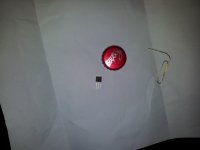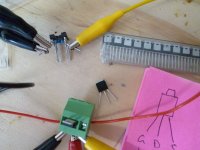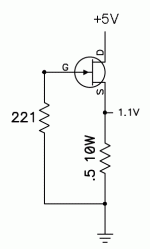Hi all,
I impulse bought some LU1014D's off ebay - they were reasonably priced and as such I took a punt and bought twenty of them. Now I've just received them, and it seems prudent to test them first before issuing positive feedback to the seller.
What procedure would you all suggest? I just Idss checked a pile of j310's and 2sk170's yesterday, as described here Transistor matching so do I need to alter this approach significantly to test the LU1014D's? I'm about to check the datasheet but it seems helpful to the community at large to tap the collective wisdom here...
Cheers all!
...oh photo attached of the wee fellas.
I impulse bought some LU1014D's off ebay - they were reasonably priced and as such I took a punt and bought twenty of them. Now I've just received them, and it seems prudent to test them first before issuing positive feedback to the seller.
What procedure would you all suggest? I just Idss checked a pile of j310's and 2sk170's yesterday, as described here Transistor matching so do I need to alter this approach significantly to test the LU1014D's? I'm about to check the datasheet but it seems helpful to the community at large to tap the collective wisdom here...
Cheers all!
...oh photo attached of the wee fellas.
Attachments
Last edited:
I hate to be a wet blanket, but I suspect that the parts you have are fakes. The very first thing you should do is connect gate to source on one of them, put 100 ohms or so in series with the drain for protection, and bias it up with a power supply or a 9V battery and a multimeter to measure current. If they don't conduct with gate shorted to source, they're fakes, plain and simple. Other tests can follow after that. There never were that many of those jfets out in the world, and certainly none since the company where I work absorbed Q-speed (a few years ago), hence my suspicion.
Will do asap. I was dubious also but figured id take a shot and see. Worst comes to worst it'll be a paypal dispute.
Ill test now and get back asap.
Ill test now and get back asap.
...oh photo attached of the wee fellas.
Based on that picture => 99% sure they are fake.
Testing
so tested with 100R on drain, test voltage of 9.1V, measured 8.88V across the resistor.
What is the range of current to be expected in this test with this part? (checks datasheet...)
so tested with 100R on drain, test voltage of 9.1V, measured 8.88V across the resistor.
What is the range of current to be expected in this test with this part? (checks datasheet...)
Last edited:
photo didn't make out text on part. Will break out a camera with a macro function asap.
...and there it is.
...and there it is.
Attachments
Last edited:
photo didn't make out text on part. Will break out a camera with a macro function asap.
The text does not matter much as the legs are too long and the shape are slightly wrong. If you take new photos - take one of the rear side too..
I received LU1014Ds two times from Lovoltech and two times from Q-speed and all I received have had identical physical appearance..
To test the devices: Ground the gate, connect drain to ca. 3 volt and source via a resistor to ground. Over the resistor you should measure ca. 1.5 volt (1.2 to 1.8) depending on the resistor value.
done - quick and rough, so I'll recheck, but using 100R resistor on source, reading 1V approx across resistor... using cheap and nasty old multi - will head to shed to get nice one...
More photo's to follow.
More photo's to follow.
Redid, showing approx 1.5V across 100R. Voltage wandered around a bit tho... Suspect the previous readings reflect a 2.8V or so supply as I recalibrated it for this one
Redid - better setup - shows ~1.1V across 100R source resistor at 3.003V on drain.
Will test with another unit and will rephoto asap.
Will test with another unit and will rephoto asap.
Next part shows 3.27V across the resistor - suspect I've cooked it, or my bodgy wiring has come unstuck.
I might just stop now, relax and come back with a better plan. The psu seems to be varying a fair bit depending on load so I'll rethink and come up with a better process to test..
For now - there's a picture of the front and back (still in packaging)
I might just stop now, relax and come back with a better plan. The psu seems to be varying a fair bit depending on load so I'll rethink and come up with a better process to test..
For now - there's a picture of the front and back (still in packaging)
Attachments
I hate to be a wet blanket, but I suspect that the parts you have are fakes... There never were that many of those jfets out in the world, and certainly none since the company where I work absorbed Q-speed (a few years ago), hence my suspicion.
I understand "Deep Surplus" bought up all remaining stock? Don't they still have them available?
If the overall length, Tab to leads is around 13.2mm they are probably correct and not fakes. There is no patent as far as I am aware, so other manufacturers can make them, like Motorola and Fairchild etc.
I understand "Deep Surplus" bought up all remaining stock? Don't they still have them available?
I picked up a bunch from them in the fall and they're all the real deal, yep.
I understand "Deep Surplus" bought up all remaining stock? Don't they still have them available?
Not all... I bought some thousands 😀
The bottom line is that if the parts conduct substantial current with gate connected to source, they are probably 1) really depletion mode devices 2) blown-up fakes.
If adding a resistor to the source and connecting the gate below it through a 1k stopper resistor turns the part into a current source, with more or less constant current vs. input voltage (I'd start with ~100 ohms in series with the source), then again it's probably the real deal. Keep in mind the original parts were rated for 24V Vds when performing the test.
I didn't know about the Deep Surplus deal. It stands to reason that if Q-Speed could get rid of their stock of a device they didn't want to promote/carry any further and maybe make a little money on the deal, they would... I should ask one of the few remaining Q-Speed employees among my colleagues what the real deal is...
If adding a resistor to the source and connecting the gate below it through a 1k stopper resistor turns the part into a current source, with more or less constant current vs. input voltage (I'd start with ~100 ohms in series with the source), then again it's probably the real deal. Keep in mind the original parts were rated for 24V Vds when performing the test.
I didn't know about the Deep Surplus deal. It stands to reason that if Q-Speed could get rid of their stock of a device they didn't want to promote/carry any further and maybe make a little money on the deal, they would... I should ask one of the few remaining Q-Speed employees among my colleagues what the real deal is...
I didn't know about the Deep Surplus deal. It stands to reason that if Q-Speed could get rid of their stock of a device they didn't want to promote/carry any further and maybe make a little money on the deal, they would... I should ask one of the few remaining Q-Speed employees among my colleagues what the real deal is...
If you do then ask if they know what happened with the LB1010D in TO263 packages.
I tried to buy those beauties...
I got my last shipment of LU1014D in may 2008..
At the time there was less than 10000 left in stock.
After considering all the options for testing I... just measured the length. Neither the total length nor the leg length matches the datasheet, so I guess that makes them fakes.
Oh well! Wonder what they actually are?
Oh well! Wonder what they actually are?
...and to confirm, with
Gate ->1K5-> GND
Drain to VCC (15v to 6v)
Source -> 100R -> GND
Current varies with VCC.
Thats a bust then. Oh well.
Gate ->1K5-> GND
Drain to VCC (15v to 6v)
Source -> 100R -> GND
Current varies with VCC.
Thats a bust then. Oh well.
- Status
- Not open for further replies.
- Home
- Amplifiers
- Pass Labs
- LU1014D on ebay - how to test to prove it's not a fake?



